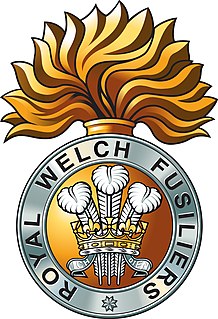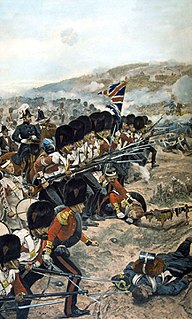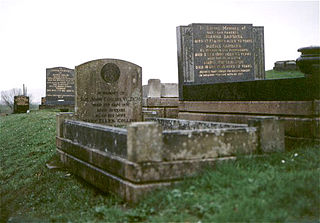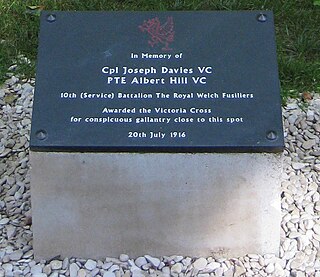
Caernarfon is a royal town, community, and port in Gwynedd, Wales, with a population of 9,852. It lies along the A487 road, on the eastern shore of the Menai Strait, opposite the Isle of Anglesey. The city of Bangor is 8.6 miles (13.8 km) to the north-east, while Snowdonia fringes Caernarfon to the east and south-east. Carnarvon and Caernarvon are Anglicised spellings that were superseded in 1926 and 1974 respectively.

The Royal Welch Fusiliers was a line infantry regiment of the British Army and part of the Prince of Wales' Division, founded in 1689 shortly after the Glorious Revolution. In 1702, it was designated a fusilier regiment and became The Welch Regiment of Fusiliers; the prefix "Royal" was added in 1713, then confirmed in 1714 when George I named it The Prince of Wales's Own Royal Regiment of Welsh Fusiliers. After the 1751 reforms that standardised the naming and numbering of regiments, it became the 23rd Foot.

The Fusiliers Museum of Northumberland, formerly the Northumberland Fusiliers Museum, is a museum located within the Abbot's Tower of Alnwick Castle in Alnwick, Northumberland, England.

Frederick Barter VC MC was a Welsh recipient of the Victoria Cross, the highest and most prestigious award for gallantry in the face of the enemy that can be awarded to British and Commonwealth forces.

Major General Edward William Derrington Bell, was a British Army officer and a recipient of the Victoria Cross, the highest award for gallantry in the face of the enemy that can be awarded to British and Commonwealth forces.

William Herbert Waring VC MM was a Welsh recipient of the Victoria Cross, the highest and most prestigious award for gallantry in the face of the enemy that can be awarded to British and Commonwealth forces.
Henry Weale VC was a Welsh recipient of the Victoria Cross, the highest and most prestigious award for gallantry in the face of the enemy that can be awarded to British and Commonwealth forces.

John Collins VC, DCM was a recipient of the Victoria Cross, the highest and most prestigious award for gallantry in the face of the enemy that can be awarded to British and Commonwealth forces.
James Llewellyn Davies VC was a Welsh recipient of the Victoria Cross, the highest and most prestigious award for gallantry in the face of the enemy that can be awarded to British and Commonwealth forces.

Joseph John Davies was a British recipient of the Victoria Cross, the highest and most prestigious award for gallantry in the face of the enemy that can be awarded to British and Commonwealth forces.

George Monger was an English recipient of the Victoria Cross, the highest and most prestigious award for gallantry in the face of the enemy that can be awarded to British and Commonwealth forces.

The Royal Welsh is an infantry regiment of the British Army. After the restructuring and reorganisation of the army in 2006, the Royal Welsh is one of three regiments to trace its lineage and draw its recruits primarily from Wales.

The Royal Regiment of Wales was an infantry regiment of the British Army, part of the Prince of Wales' Division. It was formed in 1969 by the amalgamation of the South Wales Borderers and the Welch Regiment. The 1st Battalion, The Royal Regiment of Wales had a short existence in military terms, just over 36 years. Within two months of amalgamation, the battalion was one of the first units to be deployed to Northern Ireland.
The Royal Welsh Regiment was an infantry regiment of the Territorial Army in the United Kingdom. It existed from 1999, until it was re-designated as the 3rd Battalion, The Royal Welsh in 2006.
In countries whose armies are organised on a regimental basis, such as the army of the United Kingdom, a regimental museum is a military museum dedicated to the history of a specific army regiment.
Firing Line: Cardiff Castle Museum of the Welsh Soldier is a museum which exhibits the collections of the 1st The Queen's Dragoon Guards and the Royal Welsh. It occupies the lower floor of the interpretation centre at Cardiff Castle.

The Regimental Museum of The Royal Welsh, formerly the South Wales Borderers Museum is located at Brecon in Wales. The museum's collection is made up of artefacts collected from a variety of sources from around the world and which display the regiment's 300-year history.

The Royal Regiment of Fusiliers Museum is situated on the first floor of St John's House in Warwick, England.
"The Royal Welch Fusiliers" is a march composed by John Philip Sousa in 1929, and then rewritten in 1930. It is the only march written by Sousa for a British Army regiment.

Caernarfon Barracks is a military installation in Caernarfon, Wales.














